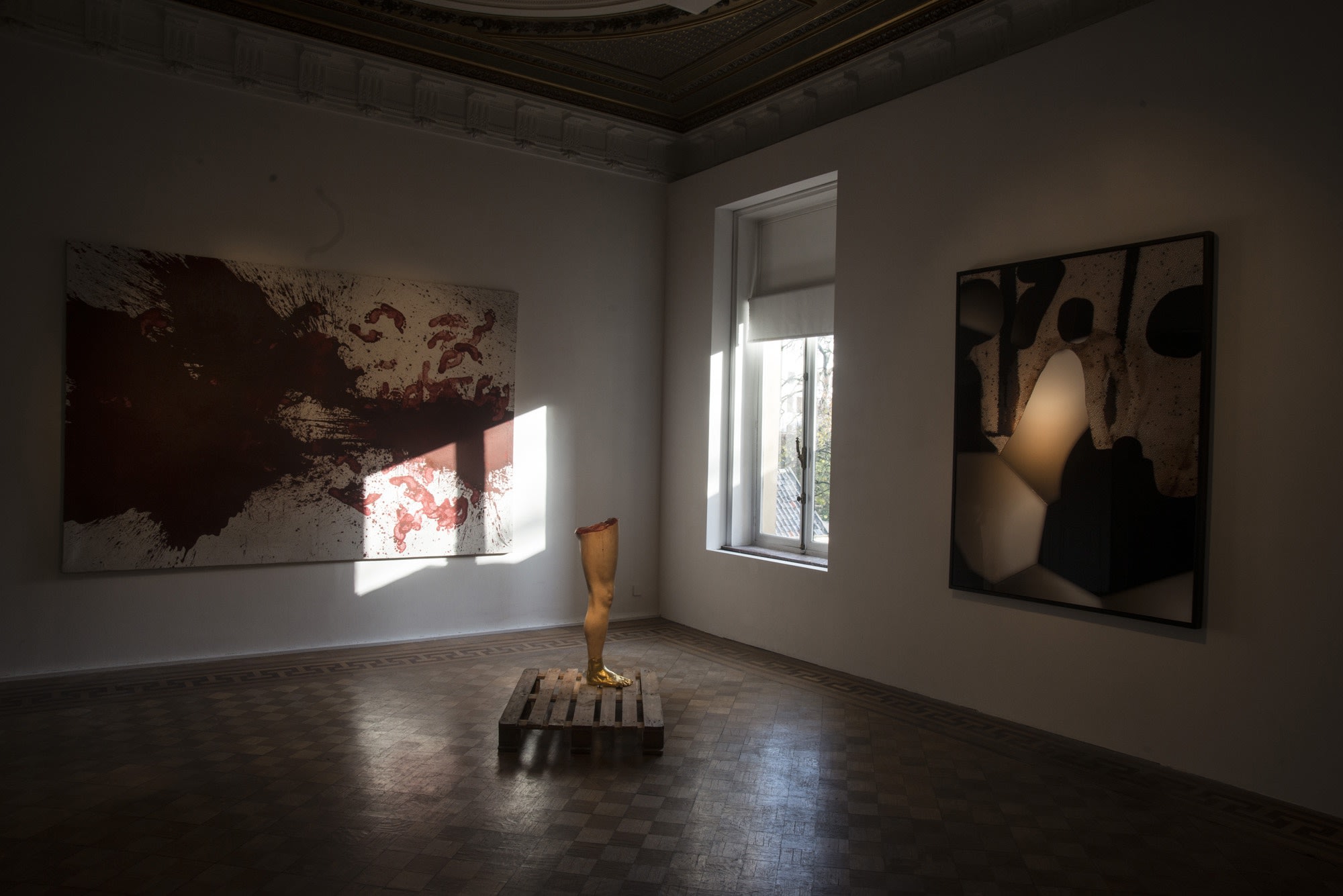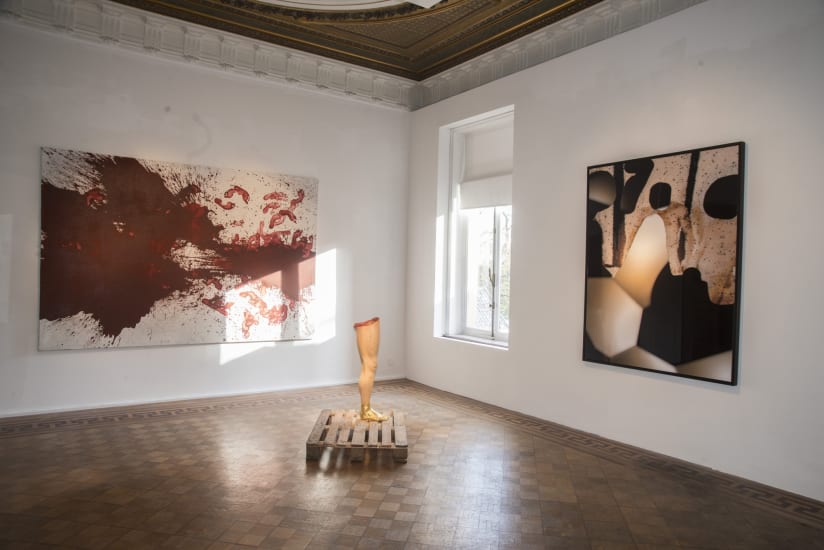
Dark Ages
20 November 2015 - 23 January 2016
Aeroplastics @ Rue Blanche Str., Brussels
group show with works by:
CARLOS AIRES - FRANCIS ALYS - RYUTA AMAE - PABLO ALONSO - GEORG BASELITZ - BEN - JOSEPH BEUYS - PIERRE BISMUTH - JOHN BOCK- EMMANUEL BORNSTEIN- DANIELE BUETTI - WERNER BÜTTNER - ANDRE BUTZER - JAMES LEE BYARS - UMBERTO CHIODI - WIM DELVOYE - HERMAN DE VRIES - FELIX DROESE - CHRISTIAN EISENBERGER - GELITIN - MIKEL GLASS - ROBERT GLIGOROV - ECKART HAHN - HANS HARTUNG - HEHE - EVA HESSE - THOMAS HIRSCHHORN - TILMAN HORNIG- JOHN ISAACS - NADAV KANDER - DANIEL KANNENBERG - DIONISIS KAVALLIERATOS - MARTIN KIPPENBERGER - LÁSZLÓ LAKNER- EMILIO LOPEZ MENCHERO - SALLY MANN - FILIP MARKIEWICZ - KRIS MARTIN - SERGEY MAXIMISHIN - CARSTEN NICOLAI - HERMANN NITSCH - THOMAS OFFHAUS - SIGMAR POLKE - GERHARD RICHTER - STEFAN RINCK - TRACEY SNELLING - DANIEL SPOERRI - TURI SIMETI- GAVIN TURK - LUC TUYMANS - GÜNTHER UECKER - MARCEL VAN EEDEN - DEL LAGRACE VOLCANO - WOLF VOSTELL - HANS WEIGAND - VINCENT WENZEL - FRANZ WEST - HEIMO ZOBERNIG
The Dark Ages denotes a period of barbarity, lethargy and decadence during which the Church exercised an excessive degree of authority and led to a deterioration of the arts. A long epoch – roughly starting as early as the 6th century – culminating in the 14th with the Black Death, unprecedented economic crises, riots and war. It is clear that today the fear of a return to an age of darkness is a very much a present concern, and no doubt points to a latent problem of our civilization to embark upon a transition, however inevitable that transition may be.
These reflections were the starting-point for the new group exhibition at AEROPLASTICS: “Dark Ages”. In collaboration with Sebastian C. Strenger (European Art Association), Jerome Jacobs explores this sombre theme through the prism of a kind of sampling from contemporary art’s recent history, as well as in works chosen by artists by way of free association. Like the Humanists who created, a posteriori, the concept of The Dark Ages (as opposed to later periods of “light”), this exhibition proposes a step back – a salutary one? – initiating a manner of (self)-critique.
The place of art and the artist has been a question central to a variety of movements since the 1950s. Thus it seems important to turn our attention there, though without getting lost in the dogmatism of definitions, in filling pigeon-holes, in a mire of diverse affiliations. This “step-back” already reveals all, and its antithesis as well. Fluxus (Joseph Beuys, Ben, Eva Hesse and, by extension, James Lee Byars) with a light and humorous touch evokes freedom of thought and action. Viennese Actionism is recalled here in the work of Hermann Nitsch. The echo of Minimalist vocabulary is present in the guise of works by Heimo Zobernig and André Butzer, while the 1980s are broached with the creative violence of the Nouveaux Fauves (Martin Kippenberger, Georg Baselitz, Werner Büttner), as well as in the work of Franz West, who offers us a cross section, from his Passstückes (“Adaptives” or “Fitting Pieces” that assimilate the work to the viewer, to his meldings of pop art with his pornographic magazine collage. Daniel Spoerri takes us back to the Nouveaux Réalistes and launches, in its wake, a series of works questioning our relationship to the object and to reality, and this in advance of our rampant consumerism. The painters Eckhart Hahn, Vincent Wenzel, Daniel Kannenberg, Mikel Glass and Emmanuel Bornstein investigate the domain of a “new surrealism” as a means of assuaging our existential agitation.
The mess of today’s economic crisis is evoked through the works “Europa macht Frei” from Filip Markiewicz, the “Disque d’Odin” of Thomas Hirschorn and in photographic mosaics by Daniele Buetti. The era of capitalism versus communism resurfaces in Joseph Beuys’s famous Kunst=Kapital, Werner Büttner’s canvas and Sergey Maximishin’s photographs. In this omnipresent media age, even dreams are polluted. Acts of violence are diverse and aesthetically mined (Carlos Aires, Robert Gligorov, John Isaacs, Nadav Kander). New realities emerge in the artistic “take” of works by Gavin Turk, HeHe and Del Lagrace Volcano. Sometimes the road taken is detoured (Pierre Bismuth), sometimes sublimated (Dionisis Kavallieratos).
“Dark Ages” is a multifaceted exhibition that shows us that, just as Medieval times were only “dark” as seen in comparison to the idea of Renaissance “light”, our recent past is only sombre when set in dissonance by its rapport to our evermore Manichean vision of a tomorrow, at once simple and redeeming.











